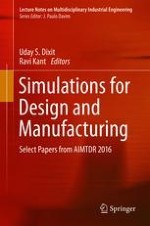2018 | OriginalPaper | Buchkapitel
Computational Fluid Dynamics Analysis of MQL Spray Parameters and Its Influence on MQL Milling of SS304
verfasst von : J. N. Rohit, K. Surendra Kumar, N. Sura Reddy, P. Kuppan, A. S. S. Balan
Erschienen in: Simulations for Design and Manufacturing
Verlag: Springer Singapore
Aktivieren Sie unsere intelligente Suche, um passende Fachinhalte oder Patente zu finden.
Wählen Sie Textabschnitte aus um mit Künstlicher Intelligenz passenden Patente zu finden. powered by
Markieren Sie Textabschnitte, um KI-gestützt weitere passende Inhalte zu finden. powered by
